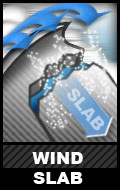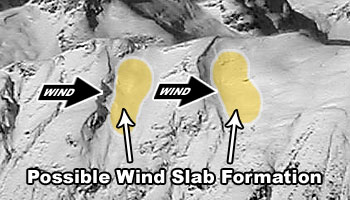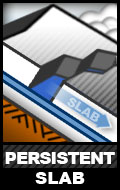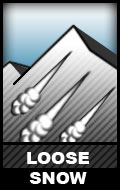Avalanche Danger Forecast
Issued Thursday, December 17, 2020 at 8pm for the greater Anchorage area Western Chugach Mountains (i.e. Chugach State Park):
*Update (Saturday, December 19, 2020 at 2pm): expect the avalanche danger to increase through Saturday due to several inches of new snow and wind loading in some areas. This weekend human triggered slabs are likely on steep terrain: wind slabs on leeward aspects and storm slabs on all aspects where the drizzle crust exists as the old snow surface. The drizzle crust will further increase the likelihood of triggering wind slabs where it exists as the old snow surface on leeward terrain. The possibility of human triggered persistent slabs will also increase due to added stress from new snow and any wind loading that occurs.
Expect more of the same: continued unsettled weather with chances for light snowfall and wind loading is expected to keep avalanche danger at moderate through this forecast period. Human triggering localized wind slabs and isolated persistent slabs remains possible on steep terrain.
Our core advisory area received 1-5″ of new snow Monday-Wednesday. This snow is capped by a crust from a freezing drizzle that fell during the daylight hours Wednesday. This crust is carve-able, and riding conditions aren’t terrible, but it’s not effortless powder skiing.
While localized winds were blowing strong enough in the Front Range to transport loose snow Thursday, the crust severely limited the amount of loose snow available for transport.
It will be important to monitor this crust in the future in terms of how it exacerbates faceting around it, and whether or not it makes for a weak interface or slick bed surface.
Avalanche Problems:
Localized wind slabs up to D2 in size remain possible above 2500′ on steep (35º+) leeward aspects. Potentially dangerous wind slabs are most likely to exist below corniced areas and along the lee sides of ridges and cross-loaded features like gullies (see graphics above).
Hollow and/or punchy feeling snow (denser wind-packed snow overlying looser and weaker snow) and pockets of deeper snow are expected to be the most prevalent indicators of wind slab danger this forecast period.
Pole probing and hand pits are a quick and effective means of assessing this problem as you travel. Use pole probing to quickly feel out areas of denser, wind-packed snow overlying looser and weaker snow. Use hand pits to quickly assess how near-surface layers of snow are bonded.
Digging a snowpit and conducting a compression test and/or extended column test will provide an even better assessment of bonding and instability before you travel on terrain of consequence.
You can also assess wind slab instability via safer “test slopes” that are representative of higher consequence terrain.
While an unlikely scenario, wind slabs do have the potential to “step down” and trigger larger and more dangerous persistent slab avalanches.
Persistent slabs up to D2.5 in size remain possible above 2500′ on terrain steeper than 35º across all aspects. A combination of hard slab and persistent weak layer reactive to human trigger may exist in isolated areas.
While persistent slabs are expected to be generally dormant and low probability, they are relatively unpredictable and have the potential to be high consequence (due to hard slab characteristics).
Recreationists have continued to explore steep terrain in recent days without reported incident, but diverse and widespread persistent weak layers exist in the snowpack. Faceted snow exists above and below crusts in some areas, sandwiched between wind packed layers in many areas, and a basal weak layer of advanced facets and depth hoar is widespread.
Obvious, red flag warnings of persistent slab danger (e.g. recent avalanches, shooting cracks, collapsing aka “whumphing“) are not expected to present themselves. Understanding how this problem is manifesting where you intend to travel is likely to require digging a snowpit, conducting instability tests, and analyzing snowpack stratigraphy.
Terrain management is simply the best way to avoid this avalanche problem: don’t expose yourself to terrain capable of producing a dangerous persistent slab.
Dry, loose snow avalanches are possible above 3000′ on very steep (38º+) terrain across all aspects. These may be in the form of naturally triggered wind-induced spindrift or human triggered sluffs. Human triggered sluffing was experienced on steep terrain Wednesday and Thursday despite the drizzle crust.
While these avalanches will be relatively small (D1), they do have the potential to cause a fall or loss of control and build up mass that “steps down” and triggers a larger slab avalanche.
Don’t let a small loose snow avalanche catch you off guard, especially if you’re on exposed terrain.
Before traveling on, through, or under terrain that has the potential to avalanche; think about the consequences and have a plan (to escape the avalanche, for re-grouping, and rescue).
Be mindful of terrains traps!
Poor visibility (due to cloudy skies and flat light) and short days increase the difficulty of mountain travel. The consequences of an accident are generally higher this time of year, and rescue efforts complicated by weather and darkness.
Click the hyperlinks and icons to learn more.
Food for thought: Ski porn: have you given it much thought? Ski movies produced by companies like Teton Gravity Research (TGR), Matchstick Productions, etc. are known as “ski porn” because, like standard pornography, these films glorify the gratifying aspects of the experience while ignoring the risks and consequences.
Ski porn stars, like their standard porn star counterparts, might have particular characteristics that make them film-worthy, but just as standard porn stars are by no means experts at making love, ski porn stars are by no means experts at traveling through the mountains. More often than not, the lauded individuals of American ski porn fame aren’t that fit (at least for the uphill), can’t climb competently, don’t know much about technical mountain travel, and aren’t adept at their own avalanche and instability assessment. They rely on helicopters and guides for everything but going fast downhill and hucking off mountain features.
Ski porn is an illusion, and don’t even get me started on the carbon footprint (and sickening hypocrisy of some carbon-gluttonous ski porn stars posing as climate activists through their involvement with silly organizations like Protect Our Winters – as if climate change should finally be an issue for privileged and affluent white folks because it threatens their winter recreational activities).
The ski porn phenomenon is especially concerning because avalanche centers often use ski porn movies for fundraising events, despite their supposed focus on public safety. While the Anchorage Avalanche Center has never used ski porn for a fundraiser, several years ago we hosted a free event that included Alaska’s first and only public screening of the French ski film “T’es Pas Bien La? (Downside Up).” Oddly enough, and hypocritically beyond any measure of sanity (because they had multiple ski porn screenings that season that weren’t for free but were for financial gain), the Anchorage Avalanche Center was criticized by the Chugach National Forest Avalanche Information Center and Alaska Avalanche School for showing and promoting the French film.
But the big difference between the French film we showed and ski porn is that, while extreme in terms of the climbing and skiing, the French film presents the whole process: the ascents and descents (sans helicopter and safety crew) of true ski-alpinists and experts at the most advanced levels of mountain travel getting after it on their own.
One of the stars of Downside Up is the Jedi ski master Vivian Bruchez. While you may not have heard of him and his exploits to the same degree you’ve heard about Cody Townsend and “The Fifty” project, the most recognizable names of American ski porn can’t hold a candle to Bruchez when it comes to climbing and skiing extreme mountains.
Thus, we present to you timely tips from Vivian on “how to ski in breakable crust” (a snow condition often found in the Western Chugach, and one that any aspiring ski-alpinist should know how to deal with):
View this post on Instagram







